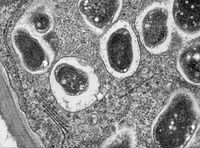
Photo from wikipedia
Atractylodes macrocephala Koidz. (AMK) is widely used owing to its pharmacological activity in traditional Chinese medicine (TCM). Here, we aimed to characterize the differentially expressed genes (DEGs) of one- and… Click to show full abstract
Atractylodes macrocephala Koidz. (AMK) is widely used owing to its pharmacological activity in traditional Chinese medicine (TCM). Here, we aimed to characterize the differentially expressed genes (DEGs) of one- and three-year growth (OYG and TYG) rhizomes of AMK combined with the endophytic bacterial diversity analysis using high-throughput RNA-sequencing. 114,572 unigenes were annotated in six public databases. 3570 DEGs revealed a clear difference, of which 936 and 2634 genes were up- and down-regulated, respectively. The results of KEGG pathway analysis indicated that DEGs corresponding to the terpenoid synthesis gene were downregulated in TYG rhizomes. 414,424 sequences corresponding to the 16S rRNA gene were divided into 1267 operational taxonomic units (OTUs). Moreover, the diversity of endophytic bacteria changed with species in OYG (773) and TYG (1201) rhizomes at OTU level, and Proteobacteria, Actinobacteria, and Bacteroidetes were the dominant phyla. Comparison of species differences among different growth years revealed that some species were significantly different, such as Actinomycetes, Variovorax, Cloacibacterium, etc. Interestingly, the decrease in the function-related metabolism of terpenoids and polyketides was found to be correlated the low expression of terpene synthesis genes in TYG rhizomes assessed using PICRUSt2. These data provide a scientific basis for elucidating the mechanism underlying metabolite accumulation and endophytic bacterial diversity in relation to the growth years in AMK.
Journal Title: Canadian journal of microbiology
Year Published: 2022
Link to full text (if available)
Share on Social Media: Sign Up to like & get
recommendations!